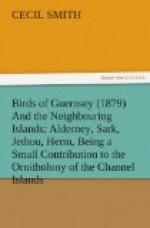as no mention is made of the immense increase of orchard-houses
in all parts of Guernsey, which has been so great
that I may fairly say that within the last few years
miles of glasshouses have been built in Guernsey alone:
these have been built mostly for the purpose of growing
grapes for the London market. These orchard-houses
have, to a certain extent, taken the place of ordinary
orchards and gardens, which have been rooted up and
destroyed to make place for this enormous extent of
glass. But what appeared to me to have made the
greatest change, and has probably had more effect
on the Ornithology of the Island, especially of that
part known as the Vale, is the enormous number of granite
quarries which are being worked there (luckily the
beautiful cliffs have hitherto escaped the granite
in those parts, probably not being so good); but in
the Vale from St. Samson’s to Fort Doyle, and
from there to the Vale Church, with the exception
of L’Ancresse Common itself, which has hitherto
escaped, the whole face of the country is changed by
quarry works and covered with small windmills used
for pumping the water from the quarries. These
quarry works and the extra population brought by them
into the Island, all of whom carry guns and shoot everything
that is fit to eat or is likely to fetch a few “doubles”
in the market, have done a good deal to thin the birds
in that part of the Islands, especially such as are
in any way fit for sale or food, and probably have
done more to make a change in the Ornithology of that
part of the Island than all the agricultural changes
mentioned by Mr. MacCulloch. Indeed, I am rather
sceptical as to the agricultural changes above described
having produced so much change in the avifauna of the
Islands during the last fifty years as Mr. MacCulloch
appears to think; there is still a great deal of undrained
or badly drained land in the Island—especially
about the Vale, the Grand Mare and L’Eree—which
might still afford a home for Moorhens, Water Rails,
and even Bitterns, and all that class of wading birds
which delight in swampy land and reed beds. Though
no doubt, as Mr. MacCulloch said, many orchards have
been destroyed to make room for more profitable crops
or for orchard-houses, still there are many orchards
left in the Island. I think, however, many, if
not all the cherry orchards (amongst which the Golden
Orioles apparently at one time luxuriated) are gone.
There is also still a great deal of hedgerow timber,
none of it indeed very large, but in places very thick;
in fact, I could point out miles of hedges in Guernsey
where the trees, mostly elm, grow so thick together
that it would be nearly impossible to pick out a place
where one could squeeze one’s horse between
the trees without rubbing one’s knees on one
side or the other, probably on both, against them,
if one found it necessary to ride across the country.
True, on a great extent of the higher part of the Island,
all along on both sides of what is known as the Forest




